

In recent years, the global incidence of cancer has shown a continuous upward trend, attracting widespread attention. With the aging population, changes in lifestyle, and environmental factors, cancer has become one of the major threats to global health.To address this challenge, active targeted cancer treatment strategies have gradually become a hot topic in the research field over the past decade.Researchers are striving to explore methods for directly delivering drugs to lesions, aiming for more precise treatment while minimizing damage to normal tissues.
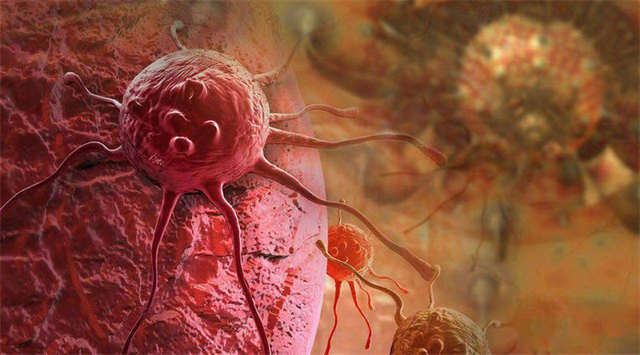
Magnetic navigation platform-guided magnetic microcarriers have rapidly developed as a new cancer-targeting strategy in recent years. However, this technology faces the challenge of rapid decay of the magnetic field deep within the body, affecting its precision and efficiency. In contrast, the dipole magnetic field navigation (DFN) technology of MRI navigation platforms shows potential and is seen as a breakthrough in the field, promising to solve existing problems in the future.
DFN utilizes soft iron magnetic spheres to generate gradient magnetic fields within MRI equipment, guiding the magnetic nanoparticles carrying drugs along precise paths, enhancing targeting capabilities. However, this technology also faces challenges such as interference with MRI magnetic fields affecting imaging quality and significant challenges posed by the strong magnetic field environment on the materials and driving mechanisms of the equipment.
Recently, researchers from the National Key Laboratory of Aerospace Structural Mechanics and Control at Nanjing University of Aeronautics and Astronautics and the Nanorobotics Laboratory at the University of Montreal conducted research addressing the pain points and difficulties of targeted delivery of cancer treatment drugs, and proposed a dynamic dipole magnetic field navigation (DFN-D) system driven by a piezoelectric robotic system in an MRI environment. This system resolves the conflict between the manipulation of drug-loaded magnetic nanoparticles (MMPs) and magnetic resonance imaging, and experimental validation has confirmed the application potential of the DFN-D system in MRI-based targeted medical systems.
The related paper on this research achievement, titled “A Piezoelectric Robotic System for MRI Targeting Assessments of Therapeutics During Dipole Field Navigation,” was published in the top journal in the field of mechatronics, “IEEE/ASME TRANSACTIONS ON MECHATRONICS,” and was nominated for the Best Paper Award of the journal in 2022.
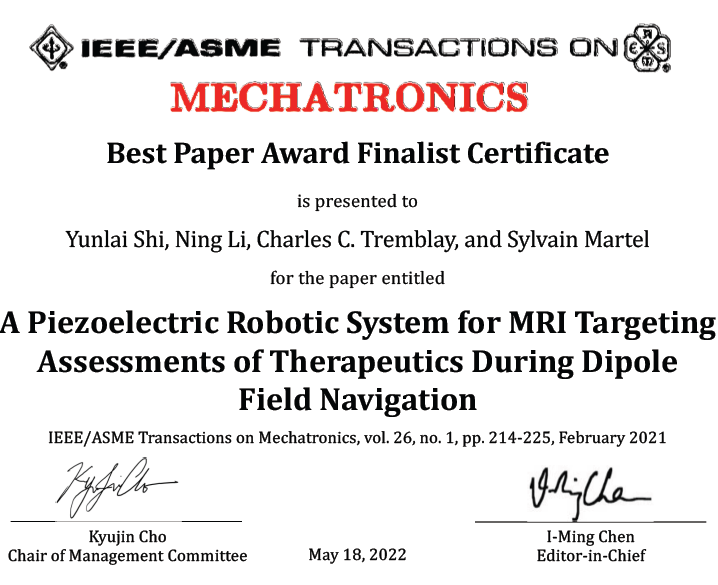 Associate Professor Shi Yunlai from the National Key Laboratory of Aerospace Structural Mechanics and Control at Nanjing University of Aeronautics and Astronautics is the first author, and PhD student Li Ning is the corresponding author. This research was supported by the China Scholarship Council, the National Natural Science Foundation of China (NO.51975282), and the Robotics Laboratory at the University of Montreal.
Associate Professor Shi Yunlai from the National Key Laboratory of Aerospace Structural Mechanics and Control at Nanjing University of Aeronautics and Astronautics is the first author, and PhD student Li Ning is the corresponding author. This research was supported by the China Scholarship Council, the National Natural Science Foundation of China (NO.51975282), and the Robotics Laboratory at the University of Montreal.
Next, let’s delve deeper into this research achievement with the Robotics Lecture Hall!▍Establishing Theoretical Models and System Design
The theoretical model of the DFN-D system was constructed to achieve precise navigation of ferromagnetic spheres within the strong uniform magnetic field of MRI equipment.
During the design process, strict consideration was given to compatibility with MRI, comprehensively evaluating the size of the ferromagnetic spheres, navigation positions, magnetic response, magnetic field strength, and the distribution characteristics of the gradient field, while also taking into account key factors such as distal positioning for MR imaging and the expected movement trajectory.
In the theoretical model development phase, researchers first explored the characteristics of the high-intensity uniform magnetic field inside MRI equipment and the mechanisms for generating magnetic gradients. The response of the ferromagnetic spheres to the magnetic field in the MRI environment was quantified through volume magnetic susceptibility, while the magnetic gradient characterized the spatial rate of change of the magnetic field in a specific direction (e.g., the z-axis).
 Coordinate system of soft iron magnetic spheres in the MRI cavity
Coordinate system of soft iron magnetic spheres in the MRI cavity
To establish the theoretical model, the research teamanalyzed the magnetic field effects produced by the ferromagnetic spheres in the MRI environment and derived a series of formulas to describe the direction and magnitude of the magnetic gradient. These mathematical expressions meticulously considered factors such as the positioning of the ferromagnetic spheres, the magnetic field parameters within the MRI equipment, and the influence of the spheres on the magnetic field layout.
 DFN-D scheme. (a) The microparticles are subjected to two forces: the gradient force caused by the magnetized spheres and the flow force. (b) For the DFN-D scheme.
DFN-D scheme. (a) The microparticles are subjected to two forces: the gradient force caused by the magnetized spheres and the flow force. (b) For the DFN-D scheme.
After establishing the theoretical model, the research team conducted a series of experiments to verify the predictive accuracy of the model and the operational reliability of the system. The experiments not only provided a comprehensive assessment of the DFN-D system’s performance but also made further adjustments and enhancements. Through these experimental validations, the research team ensured the effectiveness of the theoretical model and made necessary improvements and optimizations to the design and performance of the DFN-D system, aiming for higher navigation precision and operational stability.
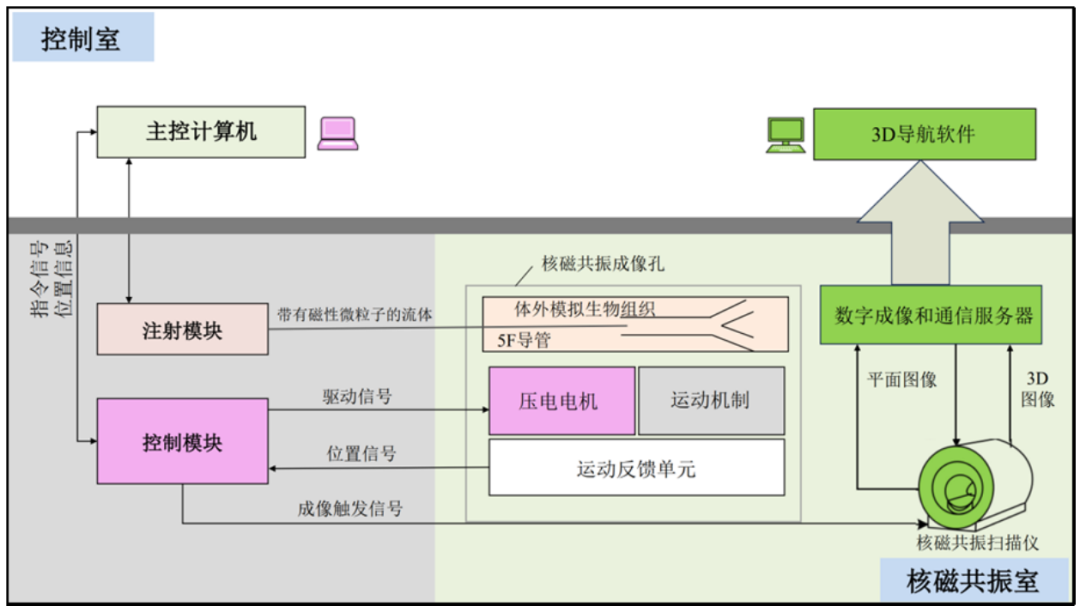 Architecture and data flow of the DFN-D system▍Design of DFN-D Mechatronic System and Construction of Experimental Platform
Architecture and data flow of the DFN-D system▍Design of DFN-D Mechatronic System and Construction of Experimental Platform
Based on the aforementioned theoretical analysis and model establishment, the researchersdesigned and manufactured a DFN-D mechatronic system to achieve precise steering of particles within the external model and MR imaging.
In designing the DFN-D mechatronic system, the researchers fully considered the unique advantages of ultrasonic motors, including their immunity to magnetic interference, low electromagnetic interference, self-locking upon power failure, fast response speed, and high positioning accuracy. Theyultimately decided to use ultrasonic motors to construct the DFN-D system and the corresponding experimental platform.
 Prototype of the DFN-D systemNOTE: The controller shield is opened here to show its internal structure; please re-shield it before conducting experiments.
Prototype of the DFN-D systemNOTE: The controller shield is opened here to show its internal structure; please re-shield it before conducting experiments.
The architecture of the DFN-D mechatronic system includes a piezoelectric robot for precise control of the position of the soft iron magnetic spheres, a controller module for generating drive signals and collecting motion feedback information, an injection module for administering therapeutic agents, a main control computer running motion and injection control programs, an external module simulating a vascular network, and a trigger interface for physical connection with the MRI scanner.
The construction of the experimental platform includes an MRI imaging device, a USB cable connector for communication with the control system, and 3D Slicer navigation software for image acquisition and analysis.
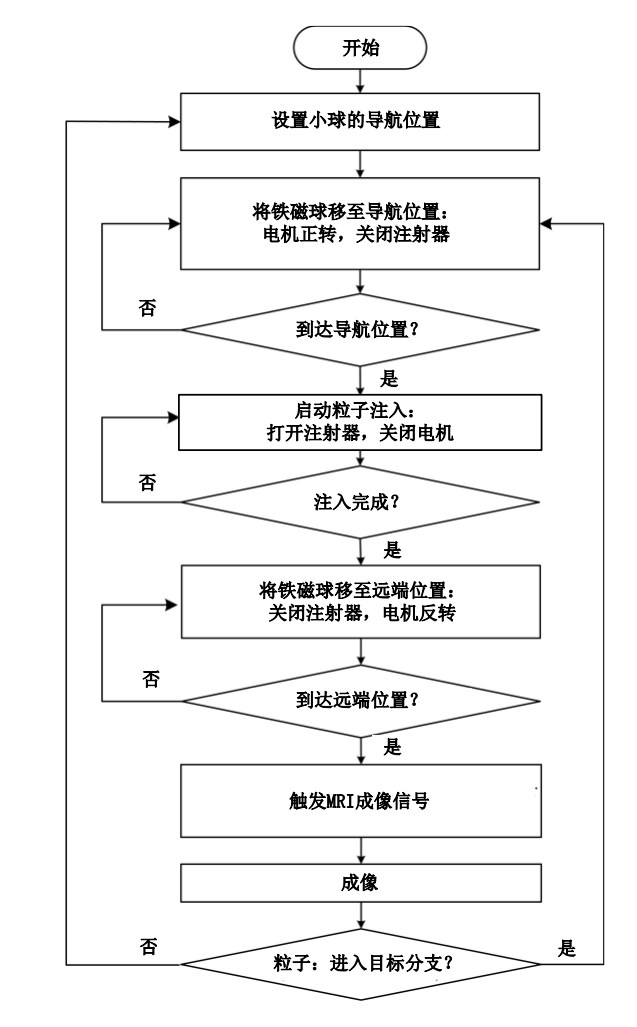 Workflow of the DFN-D system
Workflow of the DFN-D system
In terms of workflow planning, the researchers first move the soft iron magnetic spheres to the navigation position, then initiate particle injection, subsequently move the spheres to the distal position, and trigger magnetic resonance imaging. By analyzing the obtained MRI images, they evaluate the effectiveness of particle manipulation. If the particle manipulation is successful, the workflow proceeds to the next cycle; otherwise, the navigation position of the ferromagnetic spheres is reset.
The motion platform system is the core component of the DFN-D system, achieving precise and rapid control of particle movement between the navigation position and the distal position through the piezoelectric robot. To ensure MRI compatibility, all components are made of non-ferromagnetic materials, and noise interference in magnetic resonance imaging is reduced through waveguide tubes. The motion platform is constructed from aluminum profile rails, wood, and engineering plastics, paired with ceramic bearings and plastic belts as the transmission mechanism, ensuring structural rigidity and stability of the system.
 Motion platform driven by piezoelectric motors
Motion platform driven by piezoelectric motors
In the DFN-D system, a driver developed for embedded chips is used, and the entire DFN-D workflow is controlled by an Arduino Mega2560 board. Powered by a DC power supply, it employs multiple insulation measures such as aluminum foil and metal braided wires to enhance compatibility with MR imaging. The entire DFN-D mechatronic system design and experimental platform construction fully leverage the advantages of ultrasonic motors, providing reliable technical support for particle steering control and MR imaging operations, offering a new solution for further research and applications.▍Conducting Experimental Tests to Validate System Application PotentialTo evaluate the performance of the DFN-D system, the research team conducted a series of experiments, including positioning characteristic measurements, magnetic resonance imaging quality assessments, and in vitro DFN-D experiments.
In the positioning characteristic measurement experiment, the researchers manually set the positioning control to operate within a speed range of 10-80 mm/s and evaluated the system’s positioning accuracy by measuring the displacement of the motion platform. The experimental results showed that by adopting a variable speed motion control strategy, with the first 90% of the travel using a high speed of 80 mm/s and the remaining part at a low speed of 10 mm/s, the system’s positioning error could be controlled within 0.5 mm, thus achieving a small positioning error while maintaining high-speed movement.
 Relationship between positioning error and speed
Relationship between positioning error and speed
In the magnetic resonance imaging quality assessment experiment, the research team examined the impact of the DFN-D system on MRI quality. They placed a periodic image quality test model at the position of the external model and analyzed the changes in signal-to-noise ratio (SNR) under different conditions. The experimental results indicated that when the piezoelectric motor was running, the SNR of the images decreased by 19.2%, while when the motor was turned off and the soft iron magnetic sphere was moved to the distal position, the SNR further decreased by 21.6%. Nevertheless, the magnetic resonance images did not exhibit significant distortion or artifacts. Furthermore, by imaging tests with the ferromagnetic sphere moved away from the navigation position at different distances, the researchers found that when the ferromagnetic sphere was positioned 200 mm away, the image distortion was minimal, at only 2.2%, which is sufficient to ensure the correctness of the steering of the magnetic nanoparticles (MMPs).
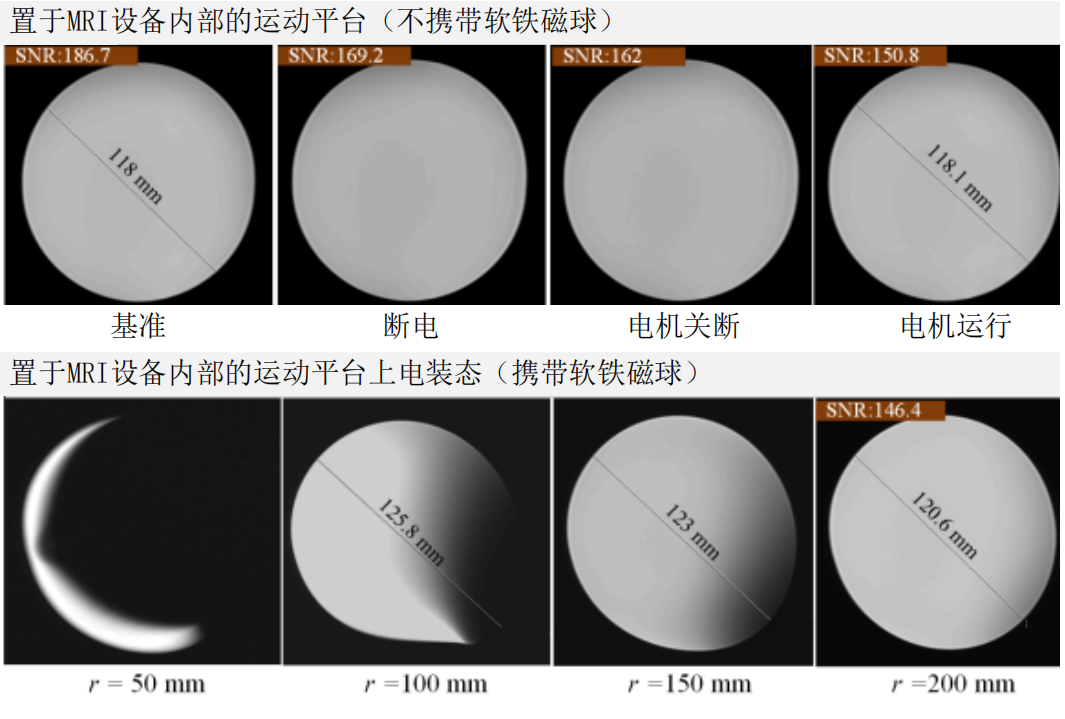 Representative T1W-Spin Echo images of cylindrical cross-sections under eight conditions
Representative T1W-Spin Echo images of cylindrical cross-sections under eight conditions
In the in vitro DFN-D experiment, the researchers validated the feasibility of particle manipulation. Following the predetermined plan, they moved the sphere to the distal position and then injected MMPs. The experiment employed a T1W-SE diagnostic imaging sequence to track the injected particle aggregates. The results showed that without navigation, the particle aggregates randomly entered sub-branches; whereas with the DFN-D system for navigation, the success rate of particle aggregates reaching both branches was 100%.
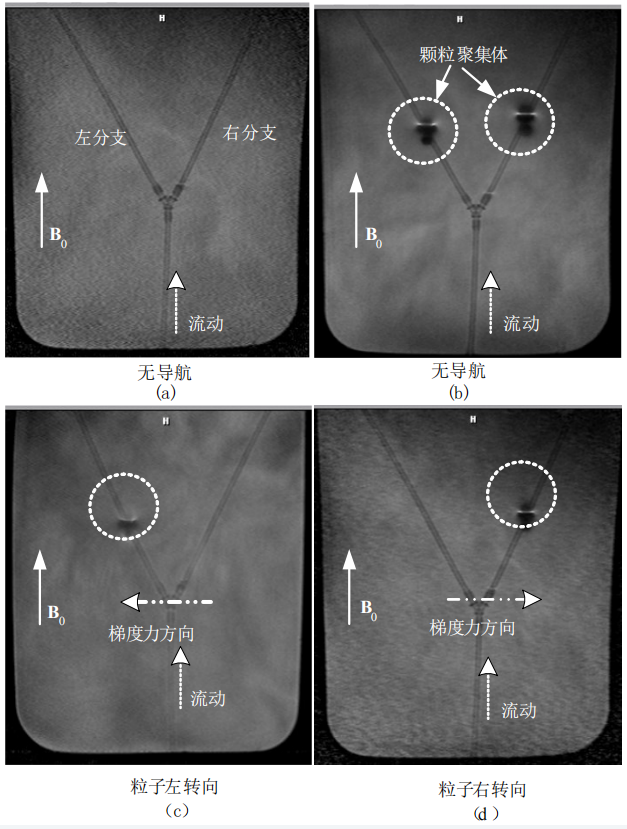 MR imaging of injected particle aggregates in the in vitro model: (a) shows MR imaging of the in vitro model before particle injection; (b) shows MR imaging of particle aggregates (injection count = 4) randomly entering different branches without navigation. In (c) and (d) (in each image, injection count = 2), the particle aggregates were successfully navigated to the left and right target branches, respectively.
MR imaging of injected particle aggregates in the in vitro model: (a) shows MR imaging of the in vitro model before particle injection; (b) shows MR imaging of particle aggregates (injection count = 4) randomly entering different branches without navigation. In (c) and (d) (in each image, injection count = 2), the particle aggregates were successfully navigated to the left and right target branches, respectively.
All these experimental studies indicate that the DFN-D system can precisely control the positioning of the motion platform, and its impact on MRI quality during motion is minimal. By optimizing the speed and position of the motion platform, the system achieves precise particle manipulation while ensuring imaging quality. The in vitro experiments further confirmed the efficiency and accuracy of the DFN-D system in controlling magnetic micro-particles, providing strong technical support for its related research and clinical applications.
Reference Article:
https://ieeexplore.ieee.org/document/9142406
For inquiries regarding corporate collaboration, please contact Dr. Tang (13810423387, same number for mobile and WeChat) for coordination.
—————-END—————-Association Introduction
The Zhejiang Robot Industry Development Association (ZRIA) was established in September 2015 and currently covers 11 regions in Zhejiang Province, with over 200 research institutions and enterprises related to robotics. It is the only provincial-level robotics industry association recognized by the Zhejiang Provincial Civil Affairs Department. The association fully leverages the advantages of provincial industry associations, integrating resources across the entire robotics industry chain, and is committed to promoting technological exchanges and industrial development in the robotics industry in Zhejiang Province.
